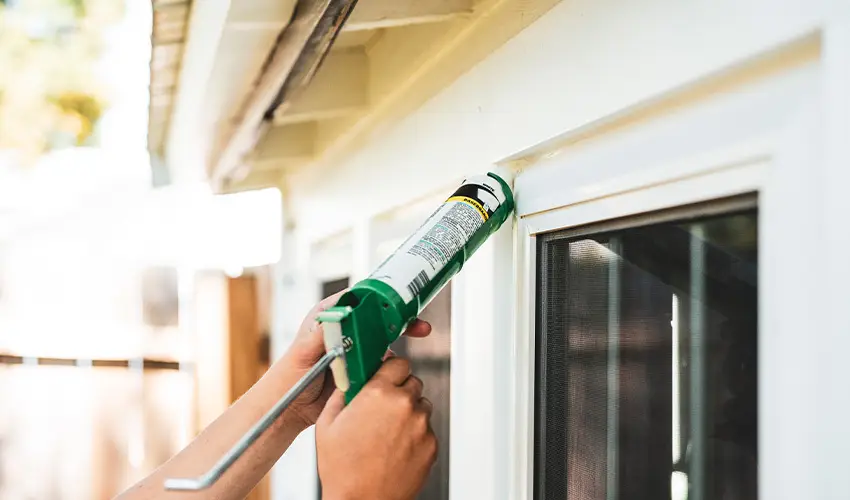Where Not to Caulk Around Windows?

The placement and shape of your windows not only give your home its character, they also serve a very functional purpose too. The type, location, and number of windows your home has will have a major impact on what it costs to heat and/or cool your home each year. If you live in an older home that has old windows, it may be time to consider an upgrade.
While installing new windows is a great way to give your home a facelift and lower your energy bills, you may not be ready for such an investment just yet. If you’re planning to replace just a few windows to start or want to do some maintenance on the ones you have, the window experts at Mr. Handyman have some helpful advice that could save you time and money.
Proper window installation requires sizing, setting, and caulking them the right way. If it’s not done correctly, you could be wasting more than just a tube of caulk. So before you get too trigger-happy with the caulking gun, let’s review where not to caulk around windows.
Should You Caulk Around Windows?
While there are many caulk options available at the local hardware store, do you really need it in the first place? Energy.gov states that heat loss through windows is responsible for 25% - 35% of energy use. So there is a case for caulking your windows since it can stop air leaks and prevent heating and cooling loss during winter and summer months.. As long as you don't caulk where you shouldn't, you’ll spend less on energy and keep you or your family comfortable throughout the year.Caulking Windows in All the Wrong Places
If you're performing maintenance on existing windows by replacing the old caulk, these tips will help make the project more efficient. You'll learn where not to caulk and how to create a weather-tight seal for your old windows that will help reduce heating and cooling loss.
Don't Get Caulk in Weep Holes
Before installing windows and applying caulk, check to see if your windows have weep holes. While the majority do — wood, vinyl, and metal window frames included — some manufacturers sell styles that don’t. These windows usually have a sloped lower sill that redirects water away from the windows.
Caulking over weep holes will cause a big problem because it will stop them from doing their job— preventing rot, mold, or rust from developing. Weep holes allow moisture behind the window to exit the frame. If you caulk over them, the moisture has nowhere to go. So, if you want to avoid costly repairs down the road, keep caulk away from window weep holes at all times.
Don't Caulk Around Window Trim
Many modern homes have trimmed-out windows that sit above the siding. As a rule of thumb, you should never caulk this type of window. There is no reason to seal the joints because it provides no benefit. In fact, if you do, you may end up causing more harm than good. The trimming already redirects excess moisture away from the windows, adding caulk could lead to moisture getting trapped inside, which can lead to damage you may not discover until it’s too late.
Keep Caulk Away From Moveable Parts
While it may be tempting to caulk all around your windows, caulking movable parts, for instance, may cause your window to seal shut or impede its operation. The ledge above the window frame also doesn’t need any caulk. This area has a drip edge that helps keep the frame dry. Leave the top of your window caulk-free if you are replacing siding or framing.
Don't Caulk Over Old Caulk!
Unfortunately, there are no shortcuts or workarounds for this tip. You only need elbow grease, patience, and a few tools to caulk effectively. Tackle loose caulk first by prying up a corner with your putty knife. Once you get a grip, use your needle-nose pliers to peel away as much old caulk as possible.
If the caulk removal becomes more challenging, try a razor knife or sharp scraper, but be careful. Always direct the blade away from you and keep your free hand out of harm's way. Wearing eye protection is also recommended. The work is tedious, but the extra effort will save you money and time down the road. Once you've removed as much caulk as possible with your putty knife and blade, scrub away the remnants with a stiff brush. You may need to use 90% rubbing alcohol to remove any remaining residue, so be cautious not to get it on other surfaces.
Caulking Tips From the Pros
Now that you know where not to caulk around windows, how about some pro tips for where you should apply caulk? Here are some of our field-tested tips for caulking and recaulking windows.
Caulk the Inside and Outside of Windows
When dealing with older windows, professional window installers and repair experts know it’s best to apply caulk to the interior and exterior of windows. Windows require a seal on both sides to avoid air leaks and moisture problems. A caulk gun will ensure you fill gaps and get a clean line. Watch this helpful video to learn how to use a caulking gun like a pro.
Use the Correct Caulk for the Job
Walking down the caulk aisle of a home improvement store can feel overwhelming, especially when you don’t know which caulk to buy. There are dozens of types, and each works best in a particular environment and based on specific usage. You’ll find caulk for the exterior of windows, interior of windows, humid spaces, masonry siding, and other unique applications.
Caulk for the exterior side of windows must be durable and hold up to extreme weather changes. Interior-side windows need a caulk that doesn’t release harmful fumes. If you have a humid room, pick a mold-resistant and waterproof caulk. Masonry siding, often found in basements, requires a caulk compatible with both the window and masonry surface. If you have more questions, check with a local Mr. Handyman pro for advice.
Know When to Caulk for the Best Results
The type of caulk used and the outside and inside environment have a lot to do with a successful caulking job. Energy.gov recommends caulking windows during dry weather when the temperature is above 45°F. It's also best to caulk when there is low humidity to prevent the caulk from separating and cracking due to swelling. Typically, the warmer the weather, the faster the caulk will dry and adhere properly, provided the humidity outside is not too high (above 80%).
Depending on humidity levels and ventilation, silicone and acrylic latex caulk on interior windows can dry within 30 minutes. While the outside temperature isn't as critical for indoor caulking, be aware condensation on the inside of your windows may need to be remedied before you begin caulking. If possible, caulk the window's interior when it's warm enough to open it and provide adequate ventilation.
Hire a Professional Window Expert
Just how difficult are window installation, caulking, and maintenance? Installing new windows requires a lot of skill and knowledge, and caulking existing ones takes time and patience. One wrong move, and you may end up with broken glass, a damaged frame, or more work than you bargained for. Hiring a professional will save you time and prevent headaches.
Whether you need window installation, repair, or maintenance, trust your home to the local pros at Mr. Handyman®. We offer a range of home maintenance services that help homeowners get things done. Each of our service professionals has an average of 10 years of experience, and we back every job with our Neighborly Done Right Promise™. Give your windows the treatment they deserve. Contact us online or call your local Mr. Handyman today!
 Click to call
Click to call


